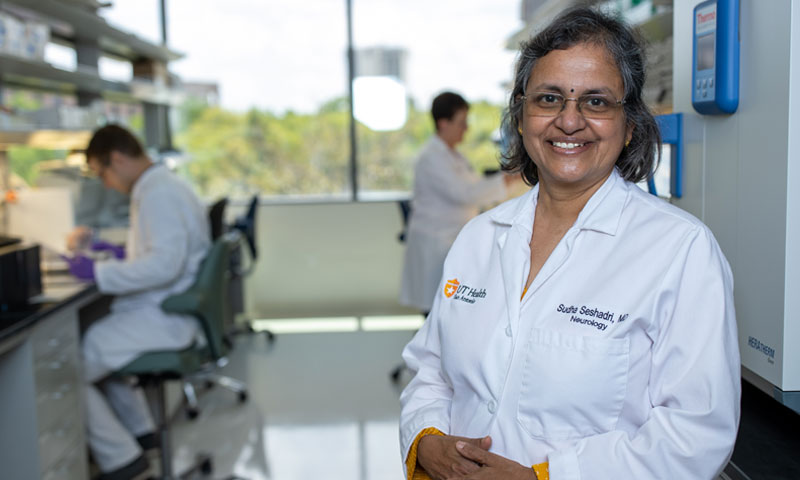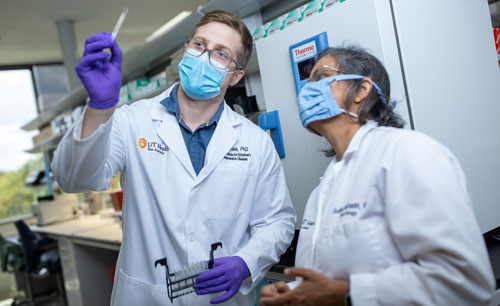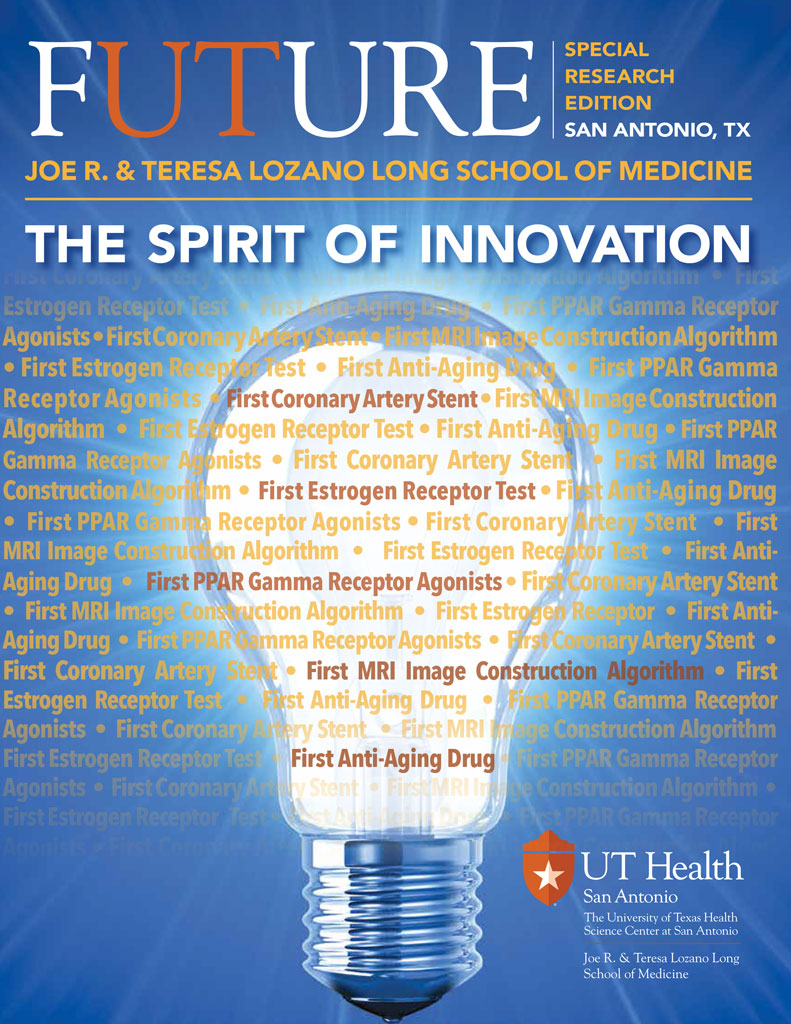The Future of Alzheimer’s and Neurodegenerative Disease Discovery

Biggs Institute Brings New Hope for Dementia Patients
Alzheimer’s and other dementias are one of the most intractable problems in all of medicine. Fewer new therapies and prognostic markers have been validated for these diseases than for almost any other disease as prevalent. Yet there is new hope for the many dementia patients who feel their disease is hopeless. For the more than 50 million people around the world with dementia, the scientific and clinical discoveries at the Joe R. and Teresa Lozano Long School of Medicine at UT Health San Antonio shine a beacon of hope.
“We believe that all persons with different types of dementia and their families need to be supported right from the earliest prevention stage and throughout the entire course of the illness,” says Sudha Seshadri, M.D., professor of neurology in the Long School of Medicine and the founding director of the Glenn Biggs Institute for Alzheimer’s and Neurodegenerative Diseases.
“The patients are our richest resource for learning about the disease, and we want to focus on studying the people of South Texas in all their rich diversity. We are interested in prevention as well as treatment of disease, that is in clinical translational research. We do basic biological, computational and epidemiological research, but always with the goal of getting directly translatable answers.”
In the almost three years since its opening, the Biggs Institute, headed by Dr. Seshadri, has garnered international attention for its multifaceted approach and has received $28.5 million in extramural funding to support its innovative research. She has created a remarkable team of scientists and clinicians: neurologists, geriatricians, neuropsychologists, social workers, geneticists, counselors, therapists and radiologists to discover and test new diagnostic and therapeutic modalities in dementias. For example, Dr. Seshadri and Claudia Satizabal, Ph.D., assistant professor in the Department of Population Health Sciences, published a study in the Journal of Neurology showing that certain genes and cardiovascular health both independently contribute to a person’s risk of dementia.
Two additional studies published within the last year showcase work being conducted at the Biggs Institute. In one, Dr. Seshadri linked an inflammatory marker called sCD14 to brain atrophy, cognitive decline and ultimately dementia. sCD14 could become a novel diagnostic marker for early dementia. The other showed the anti-aging and anti-inflammatory drug rapamycin can prevent age-related brain vascular deterioration, accumulation of abnormal amyloid and tau protein and their adverse effects of brain synaptic function. The Alzheimer’s Association and Bill Gates have awarded a $2 million grant to the Biggs to study the safety and efficacy of rapamycin in persons with very early Alzheimer’s disease through an initiative called Part the Cloud program.

CLINICAL TRIALS
“We have about 14 different clinical trials, including trials where UT Health researchers themselves uncovered promising treatments in animals,” Dr. Seshadri says. “I’m quite proud of the fact that we have three translational studies in humans based on our own research in animals.” These clinical trials were initiated from studies on fruit flies of repurposed HIV drugs, work on mice on drugs used previously for cancer, work on rapamycin, and a clinical trial to develop and test a device to explore if there may be a clue in the way a person walks which can be diagnostic of very early dementia.
One of the most exciting new studies looks at the contribution that sleep has on the progression of Alzheimer’s and related dementias, Dr. Seshadri says. Jayandra Himali, Ph.D., at the Biggs Institute recently earned a large national grant focusing on how sleep relates to dementia development. Research has showed that brain amyloid is cleared during deep sleep. The accumulation of amyloid plaques in the brain has long been thought to result in the neuronal death seen in Alzheimer’s disease. Since disturbances in sleep are common in people who have Alzheimer’s or other dementias, sometimes occurring two decades before the clinical dementia, sleep studies could provide new biomarkers and treatment options that may slow the disease’s progression by removing amyloid before it can build up enough to cause dementia.
Dr. Seshadri is nationally renowned for her studies on the genetics of Alzheimer’s disease and other dementias. For many decades, physicians have known Alzheimer’s dementia runs in families, but there are not many studies in Hispanic families. Dr. Seshadri’s research can help better define the genetic basis of susceptibility to Alzheimer’s dementia, especially in Hispanic communities, unlocking why this dementia occurs more frequently in related individuals. The entire Biggs Institute team is engaged in this project. The Biggs’ Brain Bank stores donated brain tissue from dementia patients, and the sequence and expression of genes in these brains are compared with family members and the general population. Bioinformaticists then correlate the findings to pick out specific genes that are changed in Alzheimer’s patients. Genetic counselors then trace these in family trees to assess the hereditary patterns. Asymptomatic patients with these genetic patterns are prospectively followed for the development of dementia.
One of the most promising new treatment approaches for degenerative diseases is finding the exact gene that causes it and then trying to correct it with small molecules and antisense oligonucleotides (ASO) which can partly correct the problem that the abnormal gene has created, Dr. Seshadri explains.
The Biggs Biobank is a library of biological samples including blood, saliva and tissue provided by volunteer dementia patients and their family members for research studies. The Brain Bank accepts brain donations from expired patients at no cost to surviving families, and the families receive a neuropathology report on the type and levels of pathology found, that can help family members assess their own risks for developing dementia or other neurologic diseases.
THE RIGHT FIT
Recognized as a leader in both the science and clinical care of Alzheimer’s and neurodegenerative diseases, Dr. Seshadri chose to lead the Biggs Institute because she was attracted by the vision of UT Health’s leadership and the collaborative opportunities it offered with existing programs including the Sam and Ann Barshop Institute for Longevity and Aging Studies, San Antonio’s military bases, and UT Health’s main hospital partner, the University Health System.
Currently, Dr. Seshadri is the principal investigator on 10 grants. In 2018, she was the fifth highest funded neurologist in the country, and over the past 10 years, she has garnered $50 million in funding for her research. She brings 24 years of experience and collaboration to her leadership, including her continued work with the Framingham Heart Study and Boston University.
“My role is building a very comprehensive institute which has two central themes that tie together the work of all the faculty: comprehensive patient care and cutting-edge science. Currently we have 30 faculty members who are supported by the institute. They include the clinical neurologists, psychiatrists, geriatricians who see patients, to epidemiologists doing what we call ‘population neuroscience’ where we study healthy people to understand why they develop the disease, as well as do outreach and education in our South Texas community.”
Dr. Seshadri further explains the vision of the institute is to uncover all facets that affect a person’s memory and behavior. In order to do this, they are focusing on an individualized precision medicine approach, applied to the unique population of South Texas, with its rural Hispanic majority.
The Biggs team takes a precision approach to every aspect of prevention and treatment, which requires careful examination and testing of each patient, including genomics and proteomics. For dementia patients, this involves carefully learning about the patient’s history and symptoms, very detailed examinations, brain MRI and often PET scans, blood and spinal fluid testing, along with genetic testing. The idea is to determine and address all the contributors to dementia for that patient. This approach has the ability to revolutionize dementia research and care, Dr. Seshadri says.
“We are recognizing that for most people who have dementia, it is not as simple as finding the one thing that is wrong and fixing it,” Dr. Seshadri says. Dementia is almost certainly multifactorial, with many genes interacting with the overall health of the patient and the environment in which the patient resides. Understanding why one patient with a high risk set of genes gets dementia while another does not is of paramount importance, because it can lead to new methods of prevention.
LOCATION MATTERS
The overall environment plays a key role in the development of dementia, which is why the location of the Biggs Institute is important. For dementia patients, this includes their family, their occupation, and the environmental quality in which they live. Until now, the majority of genetic testing and medical research nationwide has focused on urban populations of European descent, and over the last 30 years, dementia diagnoses have decreased some in this population. However, this is not the case when it comes to Hispanics or African Americans. Hispanics, the fastest growing minority in the country, have not been studied in detail for their risk of dementia.
Dr. Seshadri and the Biggs Institute are changing that. “This population is not only important to understand and prevent dementia in Texas but worldwide,” Dr. Seshadri says. “I believe that adding a new population into the research of dementia will lead to clues about new biology.”
One key foundation of the institute’s success is its community outreach and educational efforts. The Biggs hosts city, regional and national educational events, and has multiple on-going social media endeavors. While dementia is a defined medical disease with biochemical causes, it has been swept up with the stigma that society has for mental diseases. Some think that dementia results from a moral failure, almost as if the patient deserved it. Dr. Seshadri’s leadership is changing that view with their clinical care and clinical trials, scientific discovery and counseling services. In just three years, the Biggs Institute has provided renewed hope to those living with Alzheimer’s and other dementias as well as their families.





